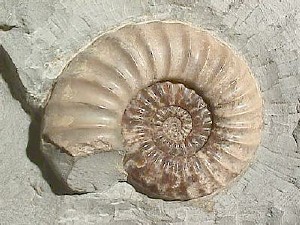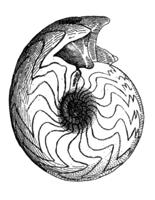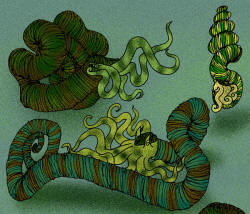|
Known as Goniatites, these
extinct
Devonion ammonoids, shelled
cephalopods are related to
squid,
octopus, and
belemnites, and they
form the order Goniatitida.
The Gonatitida originated from within the more primitive
anarcestine ammonoides
in the Middle Devonian some 390
million years ago. Surviving the Late Devonian extinction,
goniatitids flourished during the Carboniferous and
Permian only to become
extinct at the end of the Permian some 251.4 million years ago. They were
survived by their cousins the
ceratite ammonoids,
indirect descendants of the
Anarcestida.
Form
Their fossil shells usually take the
form of planispirals, although there were some
 |
| Photograph of the ammonite Asteroceras obtusum taken by
Dlloyd. The specimen is from the Jurassic Lower Lias Formation,
Obtusum Zone. Locality - Lyme Regis, Dorset, England. Complete
calcified specimen, measuring 11.5 cm (4.5") in diameter, in
limestone matrix. |
 |
| Artist reconstruction of Asteroceras |
helically-spiraled and
non-spiraled forms (known as "heteromorphs"). Their name came from their
spiral shape as their fossilized shells somewhat resemble tightly-coiled
rams' horns.
Pliny the Elder (d. 79
A.D. near Pompeii) called fossils of these animals
ammonis cornua ("horns of
Ammon") because the Egyptian god Ammon (Amun)
was typically depicted wearing ram's horns.
Often the name of an ammonite genus ends in -ceras,
which is Greek for "horn" (for
instance,
Pleuroceras).
Life
Because ammonites and their close relatives are extinct,
little is known about their way of life. Their soft body parts are very
rarely preserved in any detail. Nonetheless, much has been worked out by
examining ammonoid shells and by using models of these shells in water
tanks.
Many ammonoids probably lived in the
open water of ancient seas, rather than at the sea bottom. This is suggested
by the fact that their fossils are often found in rocks that were laid down
under conditions where no
bottom-dwelling life is
found. Many of them (such as Oxynoticeras)
are thought to have been good swimmers with flattened, discus-shaped,
streamlined shells, although some ammonoids were less effective swimmers and
were likely to have been slow-swimming bottom-dwellers. Ammonites and their
kin probably preyed on fish,
crustaceans and other
small creatures, while they themselves were preyed upon by such marine
reptiles as
mosasaurs. Fossilized
ammonoids have been found showing teeth marks from such attacks. They may
have avoided predation by squirting
ink, much like modern
cephalopods; ink is occasionally preserved in fossil specimens.
The soft body of the creature
occupied the largest segments of the shell at the end of the coil. The
smaller earlier segments were walled off and the animal could maintain its
buoyancy by filling them with gas. Thus the smaller sections of the coil
would have floated above the larger sections.
Shell Anatomy and Diversity
Basic Shell
Anatomy
The chambered part of the ammonite
shell is called a
phragmocone. The
phragmocone contains a series of progressively larger chambers, called
camerae (sing.
camera) that are divided
by thin walls called
septa (sing.
septum). Only the last and
largest chamber, the
body chamber, was
occupied by the living animal at any given moment. As it grew, it added
newer and larger chambers to the open end of the coil. A thin living tube
called a
siphuncle passed
through the septa, extending from the ammonite's body into the empty shell
chambers. Through a hyperosmotic active transport process, the ammonite
emptied water out of these shell chambers. This enabled it to control the
buoyancy of the shell
and thereby rise or descend in the water column.
A primary difference between ammonites and nautiloids is
that the siphuncle of ammonites (excepting Clymeniina) runs along the
ventral periphery of the septa and camerae (i.e., the inner surface of the
outer axis of the shell), while the siphuncle of nautiloids runs more or
less through the center of the septa and camerae.
Sexual
Dimorphism
One feature found in shells of the
modern Nautilus is the variation in the shape and size of the shell
according to the
sex of the animal, the shell of the male
being slightly smaller and wider than that of the female. This
sexual dimorphism is
thought to be an explanation for the variation in size of certain ammonite
shells of the same species, the larger shell (called a
macroconch) being female,
and the smaller shell (called a microconch)
being male. This is thought to be because the female required a larger body
size for egg production. A good example of this sexual variation is found in
Bifericeras from
the early part of the Jurassic period of
Europe.
It is only in relatively recent years
that the sexual variation in the shells of ammonites has been recognized.
The macroconch and
microconch of one
species were often previously mistaken for two closely related but different
species occurring in the same rocks. However, these "pairs" were so
consistently found together that it became apparent that they were in fact
sexual forms of the same species.
Variations
in Shape
The majority of ammonite species
feature a shell that is a planispiral flat coil, but other species feature a
shell that is nearly strght (as in
baculites). Still other
species' shells are coiled helically, superficially like that of a large
gastropod (as in
Turrilites
and Bostrychoceras).
Some species' shells are even initially uncoiled, then partially coiled, and
finally straight at maturity (as in
Australiceras).
These partially uncoiled and totally uncoiled forms began to diversify
mainly during the early part of the Cretaceous and are known as
heteromorphs.
Perhaps the most extreme and bizarre
looking example of a heteromorph is
Nipponites, which
appears to be a tangle of irregular whorls lacking any obvious symmetrical
coiling. However, upon closer inspection the shell proves to be a
three-dimensional network of connected "U" shapes.
Nipponites
occurs in rocks of the upper part of the Cretaceous in Japan and the USA.
Ammonites vary greatly in the
ornamentation (surface relief) of their shells. Some may be smooth and
relatively featureless, except for growth lines, and resemble that of the
modern Nautilus. In
others various patterns of spiral ridges and ribs or even spines are shown.
This type of ornamentation of the shell is especially evident in the later
ammonites of the Cretaceous.
Soft Parts
Although ammonites do occur in
exceptional lagerstatten such as the
Solnhoffen, their soft
part record is surprisingly bleak - beyond a tentative ink sac and possible
digestive organs, no soft parts are known at all.
It can be tentatively assumed that they had numerous tentacles, each quite
weak, and engulfed prey almost whole.
Size
Few of the ammonites occurring in the
lower and middle part of the Jurassic period
 |
| 2-metre (6.5-foot) Parapuzosia seppenradensis cast in
Germany (Picture
Source) |
reach a size exceeding 23
centimetres (9 inches) in diameter. Much larger forms are found in the later
rocks of the upper part of the Jurassic and the lower part of the
Cretaceous, such as Titanites
from the Portland Stone of Jurassic of southern England, which is often 53
centimetres (2 feet) in diameter, and
Parapuzosia seppenradensis
of the Cretaceous period of Germany, which is one of the largest known
ammonites, sometimes reaching 2 metres (6.5 feet) in diameter. The largest
documented North American ammonite
is
Parapuzosia bradyi
from the Cretaceous with specimens measuring 137 centimetres (4.5 feet) in
diameter, although a new 2.3-metre (7.5-foot) British Columbian specimen, if
authentic, would appear to trump even the European champion.
Distribution
Due to their
free-swimming and/or
free-floating habits,
ammonites often happened to live directly above seafloor waters so poor in
oxygen as to prevent the establishment of animal life on the seafloor. When
upon death the ammonites fell to this seafloor and were gradually buried in
accumulating sediment, bacterial decomposition of these corpses often tipped
the delicate balance of local
redox conditions
sufficiently to lower the local solubility of minerals dissolved in the
seawater, notably
phosphates and
carbonates. The
resulting spontaneous concentric precipitation of minerals around a fossil
is called a
concretion and is
responsible for the outstanding preservation of many ammonite fossils.
When ammonites are found in
clays their original
mother-of-pearl coating
is often preserved. This type of preservation is found in ammonites such as
Hoplites from the
Cretaceous
Gault clay of
Folkestone in Kent, England.
The Cretaceous Pierre Shale formation
of the United States and Canada is well known
for the abundant ammonite fauna it yields, including
Baculites,
Placenticeras,
Scaphites,
Hoploscaphites, and
Jeletzkytes, as well as
many uncoiled forms. Many of these also have much or all of the original
shell, as well as the complete body chamber, still intact. Many Pierre Shale
ammonites, and indeed many ammonites throughout earth history, are found
inside
concretions.
Other fossils, such as many found in
Madagascar and Alberta (Canada),
display
iridescence. These
iridescent ammonites are often of gem quality (ammolite)
when polished. In no case would this iridescence have been visible during
the animal's life; additional shell layers covered it.
Ammonite fossils became less abundant
during the latter part of the Mesozoic, with none
surviving into the Cenozoic era. The last
surviving lines disappeared along with the dinosaurs 65 million years ago in
the Cretaceous-Tertiary extinction event.
That no ammonites survived the extinction event at the
end of the Cretaceous, while some nautiloid cousins survived, might be due
to differences in
ontogeny. If their
extinction was due to a
bolide strike,
plankton around the
globe could have been severely diminished, thereby dooming ammonite
reproduction during its planktonic stage.
Mythology
In medieval Europe, fossilised
ammonites were thought to be petrified snakes, and were called
"snakestones" or, more commonly in medieval England, "serpentstones". They
were taken to be evidence for the actions of saints such as
Saint Hilda and
Saint Patrick. Traders
would occasionally carve the face of a snake into the empty, wide end of the
ammonite fossil and sell them to the public. Ammonites from the
Gandaki river in
Nepal are known as
saligrams, and are
believed by Hindus to be a concrete
manifestation of God or Vishnu.
Terminological
note
The words "ammonite" and "ammonoid"
are both used quite loosely in common parlance to refer to any member of
subclass Ammonoidea. However, in stricter usage the term "ammonite" is
reserved for members of suborder Ammonitina (or sometimes even order
Ammonitida).
End of Reading
Return to the
Old Earth Ministries Online Earth
History Curriculum homepage.

Source:
Ammonite
|




